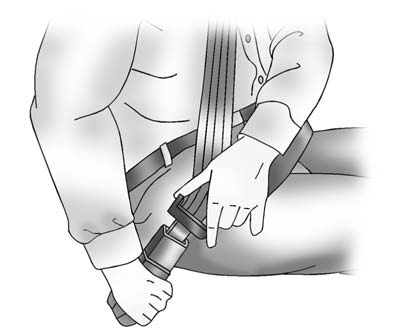Lap-Shoulder Belt
All seating positions in the vehicle have a lap-shoulder belt.
The following instructions explain how to wear a lap-shoulder belt properly.
1. Adjust the seat, if the seat is adjustable, so you can sit up straight.
To see how, see “Seats” in the Index.
2. Pick up the latch plate and pull the belt across you. Do not let it get
twisted.
The lap-shoulder belt may lock if you pull the belt across you very quickly. If this happens, let the belt go back slightly to unlock it.
Then pull the belt across you more slowly.
If the shoulder portion of a passenger belt is pulled out all the way, the child restraint locking feature may be engaged.
If this happens, let the belt go back all the way and start again.

3. Push the latch plate into the buckle until it clicks.
Pull up on the latch plate to make sure it is secure. If the belt is not long enough, see Safety Belt Extender.
Position the release button on the buckle so that the safety belt could be quickly unbuckled if necessary.
4. If equipped with a shoulder belt height adjuster, move it to the height that is right for you.
See “Shoulder Belt Height Adjuster” later in this section for instructions on use and important safety information.

5. To make the lap part tight, pull up on the shoulder belt.
It may be necessary to pull stitching on the safety belt through the latch plate to fully tighten the lap belt on smaller occupants.

To unlatch the belt, just push the button on the buckle.
Before a door is closed, be sure the safety belt is out of the way. If a door is slammed against a safety belt, damage can occur to both the safety belt and the vehicle.
See also:
Hood
To open the hood:
1. Pull the handle with this symbol on it. It is located inside the vehicle to
the lower left of the steering wheel.
2. Then go to the front of the vehicle and locate the sec ...
Storing a Flat or Spare Tire
and Tools
WARNING!
Storing a jack, a tire, or other
equipment in the passenger
compartment of the vehicle could
cause injury. In a sudden stop or
collision, loose equipment could
strike someone. Stor ...
Fuel Gauge
When the ignition is on, the fuel gauge shows about how much fuel the vehicle
has left in the tank.
An arrow on the fuel gauge indicates the side of the vehicle the fuel door is
on.
The gauge ...






